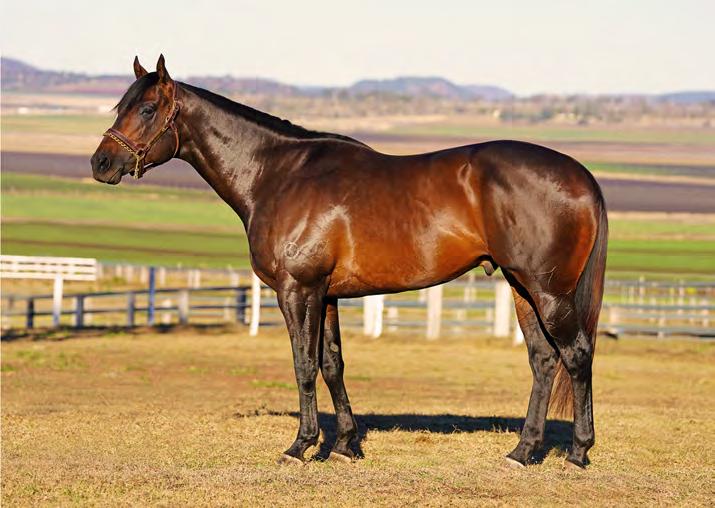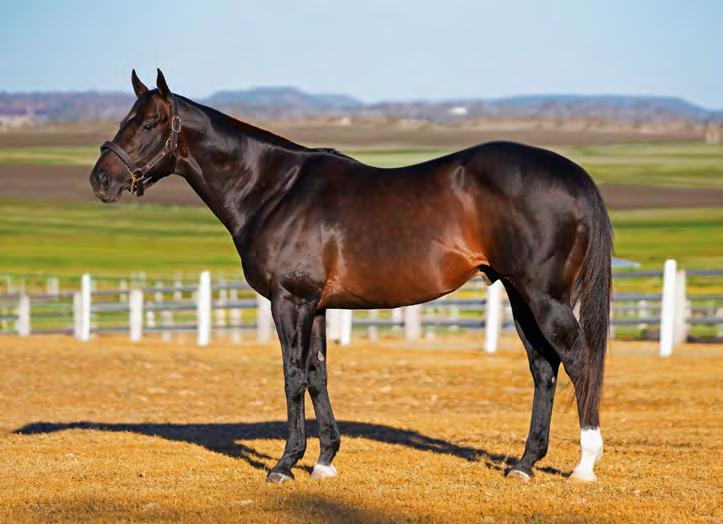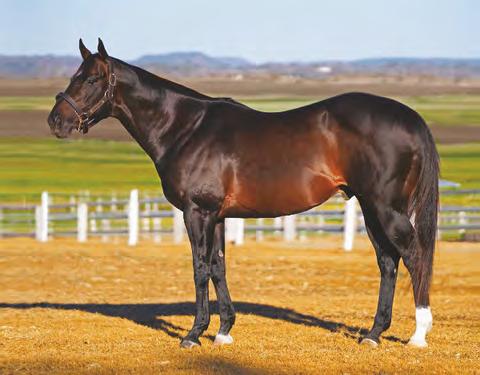
6 minute read
The Game Changers
Perhaps it’s time for someone to just come out and say it. Modern thoroughbred pedigrees, more commonly than not, have become ‘less interesting’ over time as runners across the globe continue to become more and more alike.
Don’t blame the female families. The good ones are plentiful and as diverse as ever. But what of the constant decimation suffered by the once broad spectrum of sire lines? Fashion and search for profit has always been the norm. In recent times however, there has been a profound (almost logarithmic) reduction in genetic diversity, particularly in regards to the Y chromosome and its unique contribution to the animal’s total genome.
Advertisement
In the meantime, genetics labs around the world are already well into the identification of segments within a runner’s DNA most relevant to their racing performance. Some of these studies have also uncovered a significant number of important thoroughbred pedigrees from the past which feature striking inaccuracies. Issues of descent have, in fact, been identified in a majority of the most successful of female families. Four years ago, a large group of veterinary doctors centered in Vienna reported on their Y chromosomal haplotyping to address the ancestry of key sire lines. To the astonishment of more than a few pundits, the researchers found that St. Simon, one of the nineteenth century’s greatest stallions carried the oB1 Y chromosome indicating his tail-male descendancy was through foundational sire Herod, not Eclipse - as stud books had always guaranteed.
Another group had earlier studied the mitochondrial (D-loop) DNA extracted from the preserved jaw of Bend Or, supposed winner of the 1880 English Derby winner as well as tail-male ancestor to an overwhelming proportion of contemporary thoroughbreds. As it turns out, the subject’s mDNA was shown to share a common sequence, designated L4a, which indicated he was indeed a descendant of the Martha Lynn family (#2-h) and therefore not Bend Or (out of Rouge Rose from family #1-k) but rather a different son of Doncaster named Tadcaster (ex Clemence).
Investigation into the thoroughbred’s mitochondrial DNA is now well over ten years old with clearly defined family groups or haplogroups and their subgroups or haplotypes. Renown pedigree authority and Bluebloods contributor Alan Porter has, in recent years, been referring to these distinct haplogroups and how often they repeat within the ancestry of important individuals. This is a very useful update to the powers of deep linebreeding to influential clans of the past.
Already, the game-changing (no, life-changing) development of artificial intelligence equipped with comprehensive analysis of the entire thoroughbred genome figures to catapult the grand art of pedigree analysis into something extremely different. The same number of trophies will be awarded but they’ll be sought after with whole new game plans. Nicks and inbreeding patterns (oh, no) will be replaced by dossiers filled with information regarding the presence or absence of specific gene sequences known to effect racing ability in some applicable manner.
The Speed Gene
High Tech’s first major inroad into the breeding of thoroughbreds was announced by the media in 2012 following publication in the scientific journal Nature Communications of work provided by an international collection of researchers led by UC Dublin professor Emmeline Hill and Dr. Mim Bower, an archaeo-geneticist at the University of Cambridge. This team combined to identify and then fully describe what has quite appropriately come to be known as the speed gene. The Myostatin (MSTN) gene group normally acts to limit skeletal muscle mass by regulating both the number and growth of muscle fibers. Using
PROVEN, PRECOCIOUS, POTENT
Over 7% stakes horses and 72% winners to runners
Yearlings selling up to $475,000 and averaging over $150,000 at select yearling sales in 2023
Group 1 Stallion producer and 4 time Champion Sire of QLD


Service Fee: $38,500 (inc GST)
No Foal Refund (Conditions Apply)
BY A CHAMPION, OUT OF A CHAMPION
Blue Blooded Group 1 Sprinter from the family of CANNY LAD and BIVOUAC
Progeny have sold up to $320,000 as yearlings
First crop includes multiple Group 2 winning 2yo CIFRADO
Service Fee: $13,200 (inc GST)
Live Foal Payment (Conditions Apply)
Harry
Angus McAlpine 0417 745 347 eurekastud.com.au a combination of molecular and pedigreebased approaches, the scientists traced the haplogroup backwards in time, studying the MSTN segments of hundreds of runners, including the world’s racing elite. DNA from other breeds of horses as well as distinct pieces from the skeletons of twelve historic progenitors were also evaluated (Table 1).

The key finding was the presence of variation at the MSTN locus. This included not only the ancestral ‘wild-type’ variant or T-allele but also a second cardinal variant, the result of a mutation, the C-allele which contributes to morphological changes associated with muscle hypertrophy shown to be particularly pronounced in two year-olds in training. This new bivalent genetic marker is then tested as to the likelihood of early maturity as well as greater height and muscle mass in thoroughbreds carrying the C/C allele combination of the MSTN gene. Individuals with copies of both alleles, C/T (heterozygous) figure more in the middle of the spectrum as to size, time of maturity, and optimal racing distance, while those with the T/T genotype tend to be smaller, later- maturing types with more ability over a longer course of ground.
In Table 2, the frequencies of the C and T alleles and their genotypes demonstrated a high level of concordance with the proven ability to sprint vs. route. Among 69 individuals who won a Group and/ or Listed stakes in England, Ireland, New Zealand and/or the United States at a distance of seven furlongs or less, the ratio of C allele to T allele was seven to three (0.70/0.30). This is almost the reversal (0.34/0.66) of the C/T ratio calculated from 96 elite runners from the aforementioned countries who captured at least one Group and/or Listed stakes at nine furlongs or beyond.
Another interesting finding noted in Table 2 is the significantly higher proportion of speed genes in Australia. The data suggests an overall C/T ratio that is almost at equivalence (0.51/0.49) for many of the world’s major racing centers. Down Under, however, it appears to be closer to 0.64/0.36. This ratio of close to two to one may reflect an ongoing emphasis towards precocity and speed domestically.
Genotypes of the proven stakes-winning sprinters were 46% C/C, 46% C/T with just 7% T/T (homozygous for the wildtype T-allele). Conversely, proven stakeswinning routers’ genotypes for the MSTN gene was 35% T/T, 61% C/T with just 3% C/C. Later studies replicated and validated this original research on a massively larger scale. One subsequent study found 83% of European runners with the C/C genotype had an optimum race distance of a mile or shorter while more than 89% with the T/T genotype from the sane population ran best over distances greater than a mile.
Table 2 also shows the speed gene was not identified in non-horse equids, such as donkeys or zebras. It also was not apparent in Standardbreds yet dominated MSTN genotypes in Quarter Horses by an overwhelming nine to one ratio. The horse breed carrying the highest frequency of the C variant in this study was shown to be Shetland, one of the smaller, British types who appears to have made some key contributions to the thoroughbred genome. It is the result of human selection that this new and extremely rare gene variant ultimately became common. In the late seventeenth and early eighteenth centuries, during the early years of thoroughbred development, breeders were focused on stamina for the longer distances of the day and thus, quite inadvertently, maintained very high levels of the T allele within this new elite population. This was confirmed by the researchers when all thirteen of the tested historic runners and progenitors were shown to carry the T/T MSTN genotype (Table 1).
Conditions began to change by the second half of the nineteenth century as more races were run at shorter distances with a greater number of runners starting their careers as two year-olds. As a result, the new selection process favors individuals with C/C or C/T genotypes who are much more likely to develop the musculature necessary to sprint with intense highspeed bursts. It may indeed be the T-allele that now needs replenishment.
* from Nature Communications, January 24, 2012, Hill, Bower, et al
Further investigation provided some remarkable information regarding two of the key points in the paths of transmission taken by the speed gene. Firstly, the studies ascertained the C-allele was introduced during the new breed’s foundational stages and, quite notably, as a one-time event. According to Dr. Bower, “our findings point to a Britishnative mare foaled around 300 years ago, who crossed with the three foundation stallions (Eclipse, Herod and Matchem) or their early [antecedents], as being the





